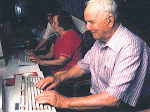 |
| Woman demonstrating proper use of ACA endorsed SA-9000X to correct a functional and/or structural and/or pathological articular change in one of her thoracic vertebrae |
In a new policy statement published in their flagship journal Online Publishing Module 53 - Chiropractic, the ACA recommends that patients who develop symptoms consistent with SOS should administer self-adjustments at home. Doing so will help prevent the total collapse of the spine, known as Accordion syndrome since first being described by chiropractor Robert Accordion in 1907. Until appropriate chiropractic care can be obtained during regularly scheduled clinic hours, the patient should refrain from any activities which might exacerbate the subluxation such as birth trauma, wearing a backpack over one shoulder, or standing underneath a piano being hoisted through an upper-story window.
"Accordion syndrome is one of our "never events", chiropractor Frank Grimes, DC, FACA, lead author of the policy statement, revealed. "The research is clear that once the spine fully collapses down on itself the patient's quality of life can suffer in a variety of ways such as being unable to reach items on high shelves, poor self-esteem and the need for permanent assisted ventilation. A self-adjustment at home, done properly, might hold the spine together until your chiropractic home opens in the morning."
The policy statement is accompanied by a technical report, "The Role of the Sudden-Onset Subluxation in Accordion Syndrome: An Update on Preventive Strategies."
The ACA asks that local, state and federal governments help distributed information on SOS to the public (see Table 1), and that chiropractors in the community begin to incorporate education on proper self-adjustment techniques at every visit. The ACA is also offering the SA-9000X, an ergonomically designed self-adjustment device based on NASA technology, at a significant discount when ordered in bulk.
"The ACA is making a definitive and powerful statement about the importance of spinal integrity to the health, safety and well-being of our populace," Dr. Grimes explained. "By advocating for self-adjustment, the ACA is promoting compelling scientific evidence that taking an active role in one's own spine health is an important public health measure."
Table 1. Sudden-Onset Subluxation (diagnosis requires 2 major criteria or 1 major PLUS 2 minor criteria)
Major Criteria
- Acute onset of any new symptom
- Acute worsening of any chronic symptom
- Exhibits all or most of the following traits: homeostasis, cellular organization, metabolism, growth, adaptation, response to stimuli, and reproduction
- Back pain
- Recent exposure to gluten or high-fructose corn syrup
- A distrust of conventional medicine
- The belief that healing energy flows from the cosmos or God down through the top of your head, through the spinal cord and into every cell of your body
- Lack of critical thinking skills
- Extreme gullibility

No comments:
Post a Comment